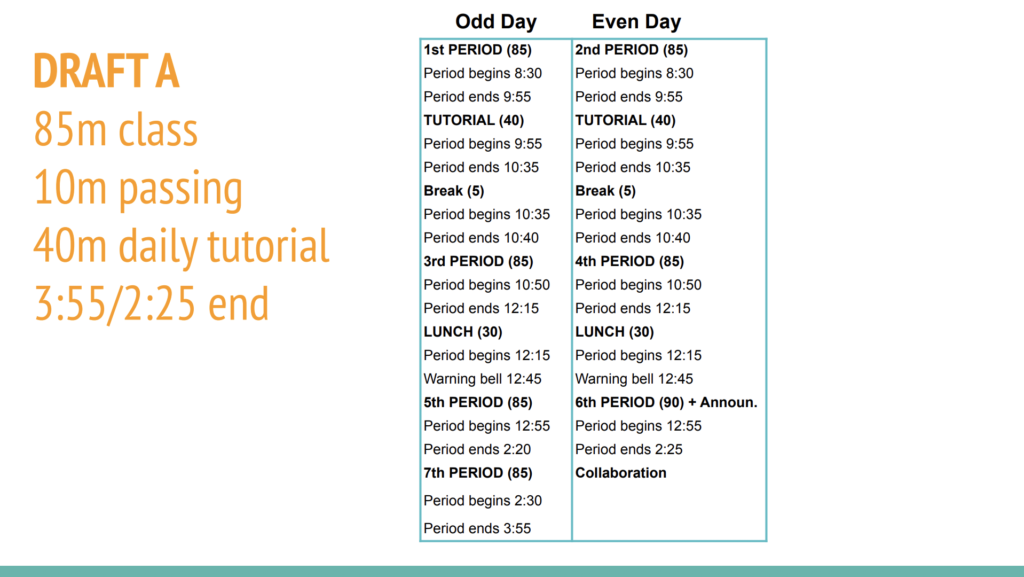The new bell schedule implemented at the start of the 2021-22 school year is likely the most unanimously disliked policy on campus. The schedule contains non-daily tutorials, inconsistent class times, an unnecessarily long announcements period and frustrating 10-minute passing periods. It is so atrocious that it is impeding students’ ability to learn and teachers’ ability to teach.
But it’s about to change: At the board meeting on Nov. 16, the Los Gatos Saratoga Joint Union High School District (LGSUHSD) Board of Trustees unanimously agreed to change the bell schedule for second semester. The new schedule will include daily tutorials, but the other specifics have yet to be determined.
The district proposed six schedule proposals to the five-member board to consider, and they chose three that they favored. The district will use the board’s feedback to create a master schedule that will be negotiated with the District Teacher Association (DTA). The new schedule will need to be announced and approved in December.
The first option (Draft A) features shortened 85-minute classes (as opposed to the current 90 minutes), 10-minute passing periods, 40-minute daily tutorials and consistent class times. It ends at 2:20 p.m. or 3:55 p.m. on Red Days, and 2:25 p.m. on Blue Days.
The second option (Draft C) features 88-minute classes, 8-minute passing periods and wildly inconsistent start times; there are daily tutorials that are 30 minutes on Red Days and 37 minutes on Blue Days. It ends at 2:19 p.m. or 3:55 p.m. on Red Days, and 2:31 p.m. on Blue Days.
The third and last option (Draft F) features 90-minute classes, 5-minute passing periods and inconsistent class start times; daily tutorials are 25 minutes on Red Days and 45 minutes on Blue Days. It ends at 2:20 p.m. or 3:55 p.m. on Red Days, and 2:45 p.m. on Blue Days.
In all honesty, the schedules are complicated, but if analyzed closely, it is clear that Draft A is the best option. The strange start times of Draft C make it a non-starter — no student is going to remember that third period starts at 10:43 a.m. or that sixth period starts at 12:58 p.m.
Draft F is attractive: It fixes warning bells by reducing passing periods to 5 minutes, keeps classes at 90 minutes and implements a daily tutorial. But the tutorials are unbalanced and the 25 minutes allotted to Red Days is simply not enough. To top it off, the schedule remains inconsistent as class times are not the same between Red and Blue Days.
So we are left with Draft A. A 40-minute tutorial is added to both Blue and Red Days, allotting teachers and students a large chunk of time to work together and combat learning loss. The schedule is consistent between Blue and Red Days, making it less confusing. School ends earlier on than all the other schedules, allowing students more time to relax at home and focus on their homework and extracurriculars.
However, it unfortunately still includes 10-minute passing periods. The district could reduce the passing periods down to 5 minutes, like in Draft F. The change would sacrifice about 2,500 instructional minutes, but could still be possible.
Unfortunately, all of the schedules have one big drawback: Red Days end at 3:55 if students have a 7th period, requiring any schedule to have the approval of the DTA, which is not guaranteed and could be complicated by ongoing compensation negotiations.
But while a supermajority of stakeholders indicated they would not support a later end time for school, a majority also indicated that they wanted daily tutorials — it’s impossible to have both, and daily tutorials are far more important. A 3:55 p.m. end time is also not bad when compared to other districts, like a 4:01 p.m. end time in the Palo Alto Union School District.
It’s important that the bell schedule is perfected next semester. The last thing all stakeholders want is to have to change this schedule again. Draft A is the closest the district will get to a perfect schedule.
So — district leaders — among these options, please choose Draft A to be the next bell schedule.


























